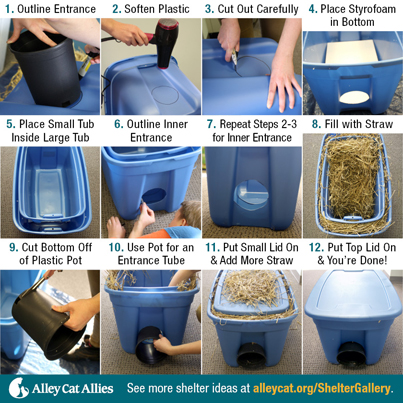TIPS FOR FERAL CAT TRAPPING
When trapping, always use a humane cat trap that is in good condition. Victoria TNR has traps to loan. Make sure the trap functions properly before setting it. A little WD40 spray lubricant can be added to the lever to make the mechanism operate more easily, if needed.
Before actual trapping, place the trap where the cat is normally fed (this will help “trick” the cat). At this time, the trap should not be set. That is, the trap door should be held open (with a twist tie, if needed) so that the cat can go in and out of the trap without the door closing. With the trap door held open, place food inside the trap. Doing this will increase your success when actually trapping because the cat will be used to going inside the trap for food.
Place the trap in a location that is out-of-sight and safe. This will help protect the animal and keep people from disturbing or taking the trap. Cats are also more likely to enter the trap when it is not in a wide-open area.
Sardines and tuna work well for bait. Smelly canned cat food may be used if canned fish is not available. Place the food on a plastic lid or small paper plate. Do not leave the actual can of food inside the trap, since the cat can cut its face and paws on the can. In cold weather, try warming the food to make it smell better or use dry food. Canned cat food will freeze within a few hours in cold weather. Leave a little food outside of the trap as well for the cat to smell and taste.
You must be sure that traps are properly “locked” or set. The back door on some traps can be lifted open and must be checked so that it is truly locked. If necessary, as a precautionary measure, secure the back flap with twist ties to make sure that it cannot be opened.
Never place the trap where a contained cat will be in the hot sun, direct wind or in an unsafe location. A piece of fabric/plastic should be placed on top of the trap in case of rain or snow. In order to calm the cat, keep an occupied trap covered with fabric at all times.
Once a trap is set, check the trap every 30 minutes and do not leave it set overnight. Traps left overnight might catch any type of animal! Cats are extremely vulnerable once they are trapped and you need to ensure their safety.
Once a cat is trapped, place the trap somewhere safe and warm overnight & keep the trap covered. Do not open the trap once there is a cat inside. Cats can usually stay in a trap for 24 hours without jeopardy to their health. Cats are very smart – do not trap a cat and then release it – you might never be able to trap that cat again.
Be sure that an occupied trap is level and is in a secure position when placed inside a car/van for transport. This way, the cat can rest comfortably and the trap will not tip over. Place plastic and fabric underneath the trap in case the cat urinates while being transported. Remember to keep the trap covered to reduce panic and stress on the feral cat.
Trapped a cat? Go here to Read this page on how to spay or neuter the cat through our program.
KEEPING FERAL CATS HEALTHY
Keeping feral cats healthy begins with TNR, but doesn’t stop there. Even feral cats need food and water and really appreciate a warm, dry shelter during cold or inclement weather.
If you’re trying to keep ants and other insects from getting into the cats’ food, you can create a little moat by putting the food bowl into a larger container. Then add about ½ inch of water in the larger bowl. The water surrounding the smaller bowl will prevent ants from reaching the food, but the cats can still lean over and eat. If you are feeding many cats, provide an adequate number of bowls to allow more than one cat to eat at one time. Providing several bowls may also help cats who might be last to the food bowl to get their share.
Since wildlife may also be interested in the food, keep the feeding area clean and free of trash. If another person is feeding, ask them to do so as well. Avoid feeding more than the cats can eat and remember to decrease the amount of food you provide as the colony size decreases so that the surplus food doesn’t attract wildlife. Because many of the wild animals who are attracted to cat food are nocturnal, feed during daylight and remove food by dark.
Coyotes are natural predators to cats. Although there aren’t any repellents registered for use on coyotes, aversion agents used for dogs and cats have been used with some success. Better, a technique used by ranchers to protect their cats is to provide a climbing pole that enables cats to escape when surprised in the open by a coyote. Feeding near an area with plenty of trees can offer escape routes and hiding places for cats.
If you can provide an enclosure that keeps the cats out of harm’s way, you may want to consider doing so. You may find inexpensive or free materials by asking building supply stores or contractors if they have scrap lumber. A fun activity is to have a shelter building party. You can also ask friends, neighbors, and co-workers for used dog houses which can be modified and serve as good shelters and contact local youth groups to find out if they would like to help build shelters as a service project. Here’s one simple way to build insulated housing for colder months:
Check out more at Alley Cat Allies.

